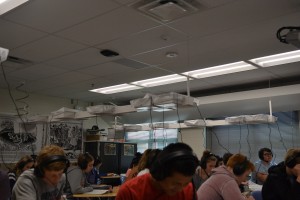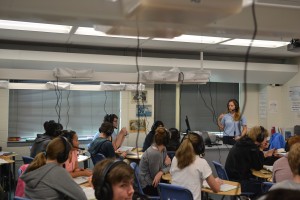
 Walking into a language classroom, you might be wondering about the gray trays hanging from the ceilings. You probably wouldn’t guess that these simple-looking machines are used for the most important exams for Spanish and French classes.
Walking into a language classroom, you might be wondering about the gray trays hanging from the ceilings. You probably wouldn’t guess that these simple-looking machines are used for the most important exams for Spanish and French classes.
Learning labs for Spanish and French classes are another installment of the ongoing construction project. In short form, they are computerized labs that hang from the ceiling with the ability to drop down to desk level to record and play back students’ voices.
According to French teacher Katherine Cardin, the new labs are an effective and interactive way to conduct tests and activities.
“The coolest things about the labs is that they allow us to practice easily and quickly,” Cardin said. “Students can hear themselves and reassess.”
The learning labs are also capable of streaming different audio into studentss headphones, anything from activity directions from a textbook to a video on YouTube.
However, their most common use is in testing for the speaking PALS exams. The labs are an improvement over the old system in which most teachers set students up recording their oral tests on a laptop in the hallway.
“[The labs] have been a blessing in the sense that it has saved us a vast amount of instructional time,” Cardin said. “It has streamlined the process: we can record and test everyone simultaneously, whereas [before] it might have taken more than one block of instructional time.”
Junior and Spanish student Brandon Ramnarine appreciates the labs and wishes they were used more often.
“They enhance the learning capability of students,” Ramnarine said. “I was in Spanish 2 last year and it was harder to talk to anyone.”
For grading, the lab software allows teachers to grade using the rubric while listening to the PALS playback recording. Teachers can access the recording playback from multiple devices.
Spanish instructor Molly Von Appen is impressed at the grading efficiency that the labs allow and believes that the thousands of dollars invested in the equipment were worthwhile.
“I do [think it was worth the money] because I think it really does help the students learn better and see where they are making their mistakes,” Von Appen said.
Because students communicate through microphones on their headsets, often staring straight ahead, the system does not mirror a real world situation of talking face-to-face in a foreign country or with foreigners. It introduces a limitation in that it lacks body language.
“You have to be more intentional about the way you act because you don’t have those visual cues,” Cardin said.
Sophomore and French and Spanish student Chloe Fauvel prefers face-to-face conversation, like the method used in previous years for PALS assessments.
“I felt more comfortable because I could see the person I was talking to,” Fauvel said. “Now we are all facing the board so when we’re talking into the headphones for speaking PALS, you don’t see the person you’re talking to and it’s really weird.”

